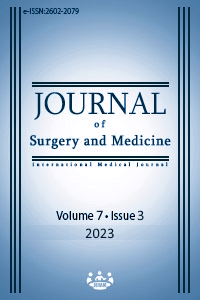Evaluation of the effect of dinoprostone vaginal ovule for cervical maturation and labor induction in term pregnancies on the duration of the third stage of labor and amount of postpartum bleeding
Evaluation of the effect of dinoprostone
Keywords:
dinoprostone, third stage duration of labor, postpartum hemorrhage, labor induction and augmentationAbstract
Background/Aim: Postpartum bleeding is a leading preventable cause of maternal death. Prolonged 3rd stage duration of labor and induction agents can increase postpartum bleeding. This study evaluated the effect of using a dinoprostone (PGE2) vaginal insert, a cervical ripening and labor induction agent, on the 3rd stage duration of labor and the amount of postpartum bleeding.
Methods: This prospective cross-sectional study involved 301 patients with vaginal delivery between 01.10.2020 and 30.06.2021. Patients were separated into two groups: PGE2+oxytocin (Group A) and only oxytocin (Group B). They were compared in terms of prepartum and postpartum data, 3rd stage duration of labor, and the amount of blood loss in the first 18 h postpartum.
Results: The median 3rd stage duration of labor was 8 min in Group A and 7 min in Group B (P=0.009). No significant differences were found between the groups in the amount of postpartum blood loss, percentage changes in hemoglobin and hematocrit values, or when patients were analyzed based on 3rd stage duration of labor (≤10 vs. >10 min). Severe postpartum hemorrhage (≥1000 ml) was associated with decreased gravida, increased body mass index, longer oxytocin use, and prolonged 3rd stage duration of labor in all patients. In Group A, severe postpartum hemorrhage was associated with decreased gravida, increased body mass index, and longer duration of PGE2 use.
Conclusion: PGE2 prolonged the 3rd stage duration of labor, but this did not increase postpartum bleeding compared to oxytocin. However, an increase in the duration of PGE2 use was associated with postpartum hemorrhage. Therefore, shortening the duration may be considered in patients with additional risk for postpartum hemorrhage.
Downloads
References
WHO. Trends in maternal mortality 2000 to 2017: estimates by WHO, UNICEF, UNFPA, World Bank Group and the United Nations Population Division [Internet]. World Health Organization, Geneva. 2019. 12 p. Available from: https://www.who.int/reproductivehealth/publications/maternal-mortality-2000-2017/en/
B-Lynch C, Keith LG, Lalonde AB. Postpartum Hemorrhage. 2010. pp.31-42
Shahid A, Rizwan S, Khawaja N. Near miss events frequency and most common causes. Pakistan J Med Heal Sci. 2015;9(3):920–2.
WHO. The WHO Near-Miss approach for Maternal Health. World Heal Organ [Internet]. 2011;1–34. Available from: www.who.int/reproductivehealth%0Ahttp://apps.who.int/iris/bitstream/10665/44692/1/9789241502221_eng.pdf
WHO. WHO recommendations for the prevention and treatment of postpartum haemorrhage [Internet]. World Health Organization. 2012. 41 p. Available from: http://www.who.int/reproductivehealth/publications/maternal_perinatal_health/9789241548502/en/
Sheldon WR, Blum J, Vogel JP, Souza JP, Gülmezoglu AM, Winikoff B; WHO Multicountry Survey on Maternal and Newborn Health Research Network. Postpartum haemorrhage management, risks, and maternal outcomes: findings from the World Health Organization Multicountry Survey on Maternal and Newborn Health. BJOG. 2014 Mar;121 Suppl 1:5-13. doi: 10.1111/1471-0528.12636. PMID: 24641530. DOI: https://doi.org/10.1111/1471-0528.12636
Reale SC, Easter SR, Xu X, Bateman BT, Farber MK. Trends in Postpartum Hemorrhage in the United States From 2010 to 2014. Anesth Analg. 2020 May;130(5):e119-e122. doi: 10.1213/ANE.0000000000004424. PMID: 31567319. DOI: https://doi.org/10.1213/ANE.0000000000004424
Deneux-Tharaux C, Bonnet MP, Tort J. Épidémiologie de l'hémorragie du post-partum [Epidemiology of post-partum haemorrhage]. J Gynecol Obstet Biol Reprod (Paris). 2014 Dec;43(10):936-50. French. doi: 10.1016/j.jgyn.2014.09.023. Epub 2014 Nov 6. PMID: 25447386. DOI: https://doi.org/10.1016/j.jgyn.2014.09.023
Prevention and Management of Postpartum Haemorrhage: Green-top Guideline No. 52. BJOG. 2017 Apr;124(5):e106-e149. doi: 10.1111/1471-0528.14178. Epub 2016 Dec 16. PMID: 27981719. DOI: https://doi.org/10.1111/1471-0528.14178
van Ast M, Goedhart MM, Luttmer R, Orelio C, Deurloo KL, Veerbeek J. The duration of the third stage in relation to postpartum hemorrhage. Birth. 2019 Dec;46(4):602-607. doi: 10.1111/birt.12441. Epub 2019 June 19. PMID: 31216383. DOI: https://doi.org/10.1111/birt.12441
Combs CA, Laros RK Jr. Prolonged third stage of labor: morbidity and risk factors. Obstet Gynecol. 1991 Jun;77(6):863-7. PMID: 2030858.
Taebi M, Kalahroudi MA, Sadat Z, Saberi F. The duration of the third stage of labor and related factors. Iran J Nurs Midwifery Res. 2012 Feb;17(2 Suppl 1):S76-9. PMID: 23833605; PMCID: PMC3696975.
Ashwal E, Melamed N, Hiersch L, Wiznitzer A, Yogev Y, Peled Y. The incidence and risk factors for retained placenta after vaginal delivery - a single center experience. J Matern Fetal Neonatal Med. 2014 Dec;27(18):1897-900. doi: 10.3109/14767058.2014.883374. Epub 2014 February 4. PMID: 24417417. DOI: https://doi.org/10.3109/14767058.2014.883374
Favilli A, Tosto V, Ceccobelli M, Bini V, Gerli S. Risk factors analysis and a scoring system proposal for the prediction of retained placenta after vaginal delivery. Eur J Obstet Gynecol Reprod Biol. 2018 Sep;228:180-185. doi: 10.1016/j.ejogrb.2018.06.033. Epub 2018 June 19. PMID: 29980112. DOI: https://doi.org/10.1016/j.ejogrb.2018.06.033
Khireddine I, Le Ray C, Dupont C, Rudigoz RC, Bouvier-Colle MH, Deneux-Tharaux C. Induction of labor and risk of postpartum hemorrhage in low risk parturients. PLoS One. 2013;8(1):e54858. doi: 10.1371/journal.pone.0054858. Epub 2013 January 25. PMID: 23382990; PMCID: PMC3555986. DOI: https://doi.org/10.1371/journal.pone.0054858
Alfirevic Z, Kelly AJ, Dowswell T. Intravenous oxytocin alone for cervical ripening and induction of labour. Cochrane Database Syst Rev. 2009 October 7;2009(4):CD003246. doi: 10.1002/14651858.CD003246.pub2. PMID: 19821304; PMCID: PMC4164045. DOI: https://doi.org/10.1002/14651858.CD003246.pub2
Frolova AI, Stout MJ, Tuuli MG, López JD, Macones GA, Cahill AG. Duration of the Third Stage of Labor and Risk of Postpartum Hemorrhage. Obstet Gynecol. 2016 May;127(5):951-956. doi: 10.1097/AOG.0000000000001399. PMID: 27054942. DOI: https://doi.org/10.1097/AOG.0000000000001399
Hannigsberg J, Dupré PF, Carpentier M, Merviel P, Collet M, Dessolle L. Repeated sustained release dinoprostone vaginal inserts in women with unfavorable cervix may increase the risk of postpartum hemorrhage: preliminary results. Eur J Obstet Gynecol Reprod Biol. 2016 Jul;202:81-2. doi: 10.1016/j.ejogrb.2016.04.034. Epub 2016 April 30. PMID: 27196084. DOI: https://doi.org/10.1016/j.ejogrb.2016.04.034
Wetta LA, Szychowski JM, Seals S, Mancuso MS, Biggio JR, Tita AT. Risk factors for uterine atony/postpartum hemorrhage requiring treatment after vaginal delivery. Am J Obstet Gynecol. 2013 Jul;209(1):51.e1-6. doi: 10.1016/j.ajog.2013.03.011. Epub 2013 March 15. PMID: 23507549; PMCID: PMC3788839. DOI: https://doi.org/10.1016/j.ajog.2013.03.011
Downloads
- 465 656
Published
Issue
Section
How to Cite
License
Copyright (c) 2023 Emine Aytemiz , Tayfur Çift , Sakine Merve Aydın
This work is licensed under a Creative Commons Attribution-NonCommercial-NoDerivatives 4.0 International License.
















